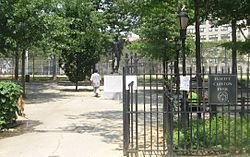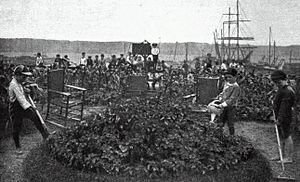DeWitt Clinton Park facts for kids
Quick facts for kids DeWitt Clinton Park |
|
|---|---|

Southeast entrance to park, with doughboy
|
|
| Type | Urban park |
| Location | Manhattan, New York City |
| Area | 5.8 acres (2.3 ha) |
| Created | 1906 |
| Operated by | New York City Department of Parks and Recreation |
| Open | 6 a.m. to 1 a.m. |
| Status | Open all year |
DeWitt Clinton Park is a 5.8-acre (23,000 m2) public park in the Hell's Kitchen area of Manhattan, New York City. You can find it between West 52nd and 54th Streets, and Eleventh and Twelfth Avenues.
This park was one of the first in Manhattan located near the busy Hudson River waterfront. It's named after DeWitt Clinton, who helped create a lot of business by opening the Erie Canal. It's the biggest city park in its neighborhood. Since 1959, the Hell's Kitchen area has often been called "Clinton" because of the park. It's also the only park on the west side of Manhattan that has lighted fields for sports.
DeWitt Clinton Park was also home to the very first community garden in New York City.
Contents
Park History: How DeWitt Clinton Park Began
The land where DeWitt Clinton Park now stands was once part of old family farms. These farms had been owned by the Striker and Hopper families for over 200 years. Their old farmhouses were taken down in the late 1800s.
New York City decided to buy this land in 1896. Other buildings on the site were removed by 1902. The park officially opened in 1906. Around the same time, the De Witt Clinton High School also opened nearby.
Original Design and the Children's Farm Garden
The park's first design in 1901 was made by Samuel Parsons Jr.. It was planned to be even bigger than it is today. The park was originally about 7.4 acres (30,000 m2) and reached almost to the Hudson River.
A special part of the park was its children's farm garden. This garden operated from 1902 to 1932. It was the first of its kind in New York City! A woman named Frances Griscom Parsons (no relation to the designer) was a big supporter of this farm. The garden had flower beds and observation plots. It also had 356 small vegetable gardens, each given to a "little farmer."
Samuel Parsons described the park as a great place for children to play. He mentioned how the land's slopes allowed for beautiful trees and shrubs. He also talked about the farm garden where hundreds of children learned to grow plants.
Changes Over Time: How the Park Has Grown and Changed
In 1930, a statue called Flanders Field Memorial was placed in the park. It shows a "doughboy," which was a nickname for American soldiers. This statue was made by Burt Johnson.
The park's size changed in 1932. A 250-foot (76 m) wide strip of land on the west side was removed. This land was needed for the West Side Elevated Highway. The soil from the park was even moved to Central Park. It was used to help create Central Park's Great Lawn.
The park's clear views of the Hudson River also changed. This happened when the New York Passenger Ship Terminal was built in 1935. Even with these changes, a curved path along the west side is still a popular spot to watch cruise ships. The children's garden was closed in 1932.
Today, the park looks different from its original design. Instead of the old lawns and music stands, you'll find fenced-in areas for three baseball fields. There are also asphalt courts for basketball and handball. Plus, there's a children's playground and a dog park.
In 1959, people living in Hell's Kitchen wanted to make the neighborhood sound nicer. They decided to rename it "Clinton" after the park.
Recent Improvements and Events
Over the years, there have been efforts to improve the park. In 1995, a German company set up a large tent for a dinner show. They promised to pay $100,000 for park improvements. However, many residents were against this. They felt it was wrong to use their only major park for a commercial event.
After the dinner show, the park was greatly improved. It got a new Erie Canal Playground with a granite rock formation. New fences and gates were added so the park could be locked at night. A dog park was also created where a Bocce court used to be.
In 1998, a new park called Hudson River Park was created across Twelfth Avenue. This much larger park is a joint project between New York City and New York State. DeWitt Clinton Park is a city park. There isn't a direct connection between the two parks because of the Passenger Terminal.
DeWitt Clinton Park is still a busy place. In 2010, it even hosted the International Quidditch Association's fourth World Cup!
Flanders Field Memorial
The base of the "doughboy" sculpture in the park has words from the famous poem, In Flanders Fields. This poem was written by John McCrae. The statue honors soldiers who fought.
Images for kids




